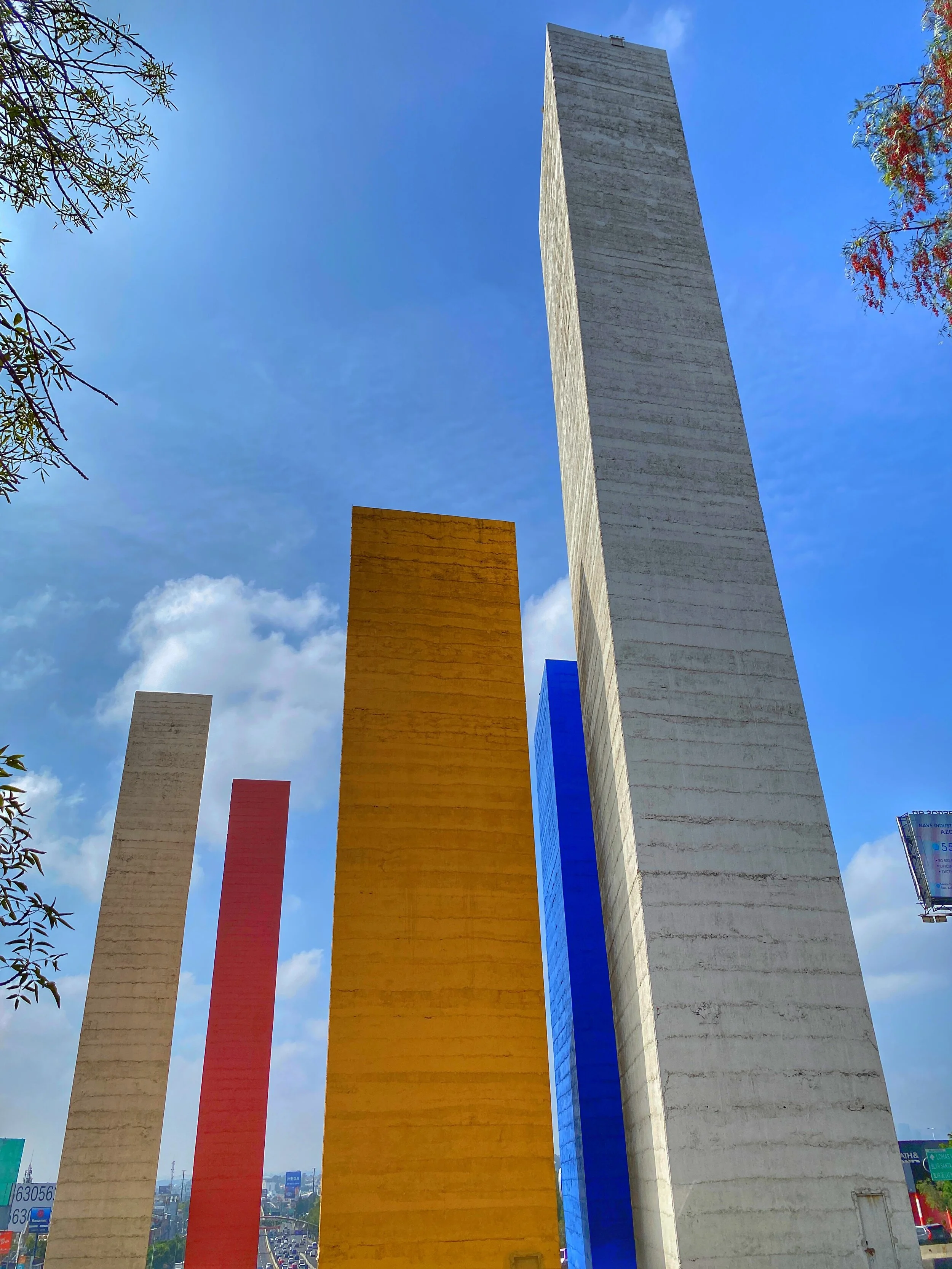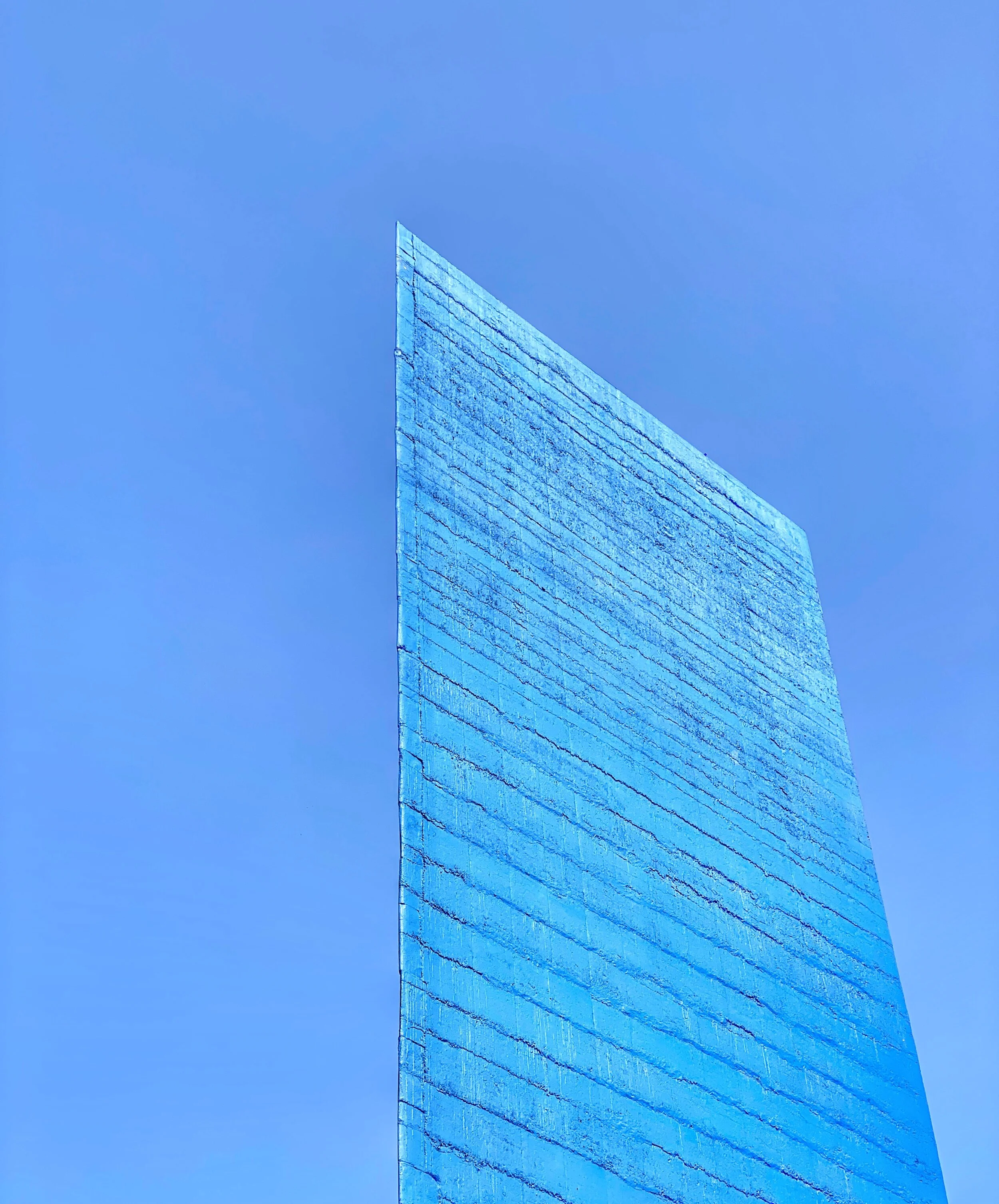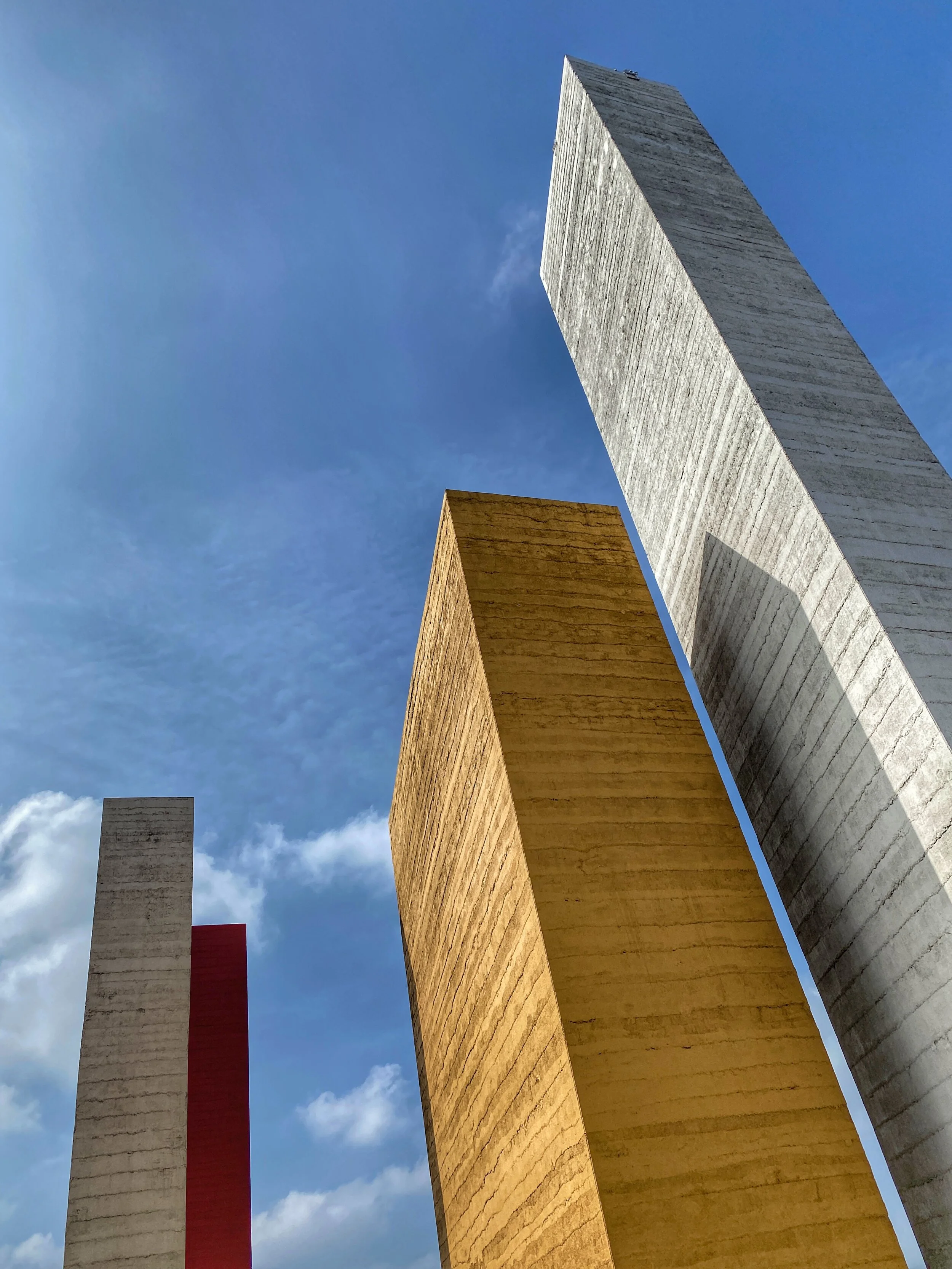Just outside of CDMX, the Satellite Towers seem to change shape before your very eyes.
“The towers make us look thinner!” Duke exclaimed.
When we first saw the Torres de Satélite (Satellite Towers), I must admit that I was not very impressed. Granted, we were speeding past them on the freeway to the northwestern suburb on the outskirts of Mexico City named, appropriately, Satélite (Merriam-Webster’s third definition of “satellite” being “a usually independent urban community situated near but not immediately adjacent to a large city”).
Seen from the freeway, the Torres de Satélite are cool but not overly impressive.
From one side, the towers look entirely rectangular, but — spoiler! — they’re not!
The five towers struck me as simple yet colorful rectangular sculptures rising into the sky. There didn’t seem to be much that was interesting about them.
But that was before we parked nearby and experienced them on foot.
“What at first seemed to be rectangular structures reveal themselves to actually be triangular.
You walk on a bit, keeping your eyes on the ever-morphing shapes, and suddenly one of the towers looks entirely flat! ”
It’s fun tooling around in a bright orange-red Volkswagen bus.
Barragán Tour With the Traveling Beetle
One of my old coworkers had told me about Luis Barragán, and while I admired the clean lines and bright colors in the photos I saw of his works, I confess that I wasn’t fully appreciative of his supposed genius as an architect.
So I was happy to hear that Duke had booked us a half-day excursion to see some of Barragán’s projects just outside of Mexico City, through a tour group called the Traveling Beetle. A brief review:
Duke and Wally posing near their sytlin’ ride for the day
The cons: It’s definitely on the expensive side at $115 per person (that’s U.S. dollars, although keep in mind that the Mexican peso also uses the $ symbol). And, as cute as the vintage 1976 VW bus was to zoom around in, there weren’t any seatbelts.
The pros: Everything else.
Indeed, it’s no exaggeration when I say that I can thank our guide, Martín, in large part for my newfound appreciation of Barragán. His passion was contagious.
The architect who designed neighborhoods in the CDMX suburb of Cuidad Satélite hired Barragán to create an iconic, bold sculpture to impress visitors to the new development.
A Dramatic Entrance to Ciudad Satélite
Our first stop of the day was an exploration of the Torres de Satélite. We pulled into a parking lot just beyond them, which Martín described as one of the best-kept secrets of the area.
Barragán was hired to create an iconic entrance to the Ciudad Satélite, which was, at the time of the Torres de Satélite’s construction in 1958, a new community. Mario Pani, an architect known for modern megaprojects, designed the neighborhood and had been impressed with Barragán’s El Pedregal, gardens developed over lava fields. Wanting something that made a similar bold statement, Pani commissioned Barragán, who collaborated on the tower design with the artist Mathias Goeritz.
“It’s a piece of art,” Martín says, as we get out of the car and head toward the towers. “They’re in between sculpture and architecture.”
The design of the Torres de Satélite was a collaboration with the Mexican artist Mathias Goeritz. This painting inspired Barragán to create the impressive monoliths.
The towers are in a concrete median in the middle of a bustling freeway, with commercial developments on either side. Note how Barragán ingeniously positioned the structures so their angles align at various vantage points.
The bright primary colors we see today weren’t the original hues, Martín informs us. Originally, the towers were painted in warm tones of ochre and orange. But when all eyes were on Mexico City for the 1968 Olympics, the city asked Barragán to refresh the palette.
As can be seen in this vintage shot, the towers originally had a different color scheme. They were updated to coincide with the 1968 Olympics in Mexico City.
It’s a bit ironic that an architect known for his intense pops of color didn’t actually choose those colors himself. Barragán worked closely with the artist Chucho Reyes, who was the one who actually determined what colors to use.
Barragán must have been pleased with the choice of primary colors, but Pani was not. In fact, the color scheme alteration caused the two architects to argue and part ways.
Are the towers rectangular? Triangular? Flat? Depends on where you’re standing!
The Optical Illusions of the Torres de Satélite
From afar, the towers look static — almost, I dare say, a bit boring. But then, upon approach, you see them transform into all sorts of dimensions and shapes. As you walk around the base of the towers, which range from 98 to over 160 feet tall, you’re constantly surprised: What at first seemed to be rectangular structures reveal themselves to actually be triangular. You walk on a bit, keeping your eyes on the ever-morphing shapes, and suddenly one of the towers looks entirely flat!
Yet another optical illusion employed by Barragán was the use of forced perspective. The rows of bricks get smaller and tighter as they progress up each tower to evoke an increased sense of height.
Note the forced perspective — the horizontal lines get closer and closer as they near the top. This makes the tower look taller that it really is. The blue was chosen to match the sky.
The door at the base of the far tower is open, so I peek my head in. There isn’t anything impressive in there — it’s just an unfinished space with some maintenance tools scattered about in the thick layer of grime. Martín tells us he saw a homeless man seeking shelter inside one of the towers on a previous visit.
I was surprised to discover that the towers are open at the top. Birds flitted about inside.
“Some people call them big birdhouses,” Martín continues. He points to the birdshit that covers the interior. “And that’s exactly what they are.”
The towers aren’t usually open, but we were able to peek inside one — and were surprised to discover that they’re open at the top.
Martín has us note how the towers cast shadows upon each other, creating additional ever-shifting lines, black shapes that mimic the malleability of the towers themselves.
“Shadow was one of Barragán’s obsessions,” he explains.
The shadows that form shifting patterns on the towers were part of Barragán’s consideration in the design. He was always aware of the power of chiaroscuro.
Pretty much any picture of the towers could be considered modern art (at least that’s what Wally thinks).
Las Torres de Satélite ended up being but an appetizer on our tour of Barragán’s suburban works (with Cuadra San Cristóbal being the main course). They seem to defy the very laws of physics and are a great introduction to the brilliance of Barragán. –Wally
Las Torres de Satélite can be combined with a tour of other Barragán works in the northwestern suburbs of Mexico City.
Torres de Satélite
Ciudad Satélite
53100 Naucalpan de Juárez
State of Mexico
Mexico



































